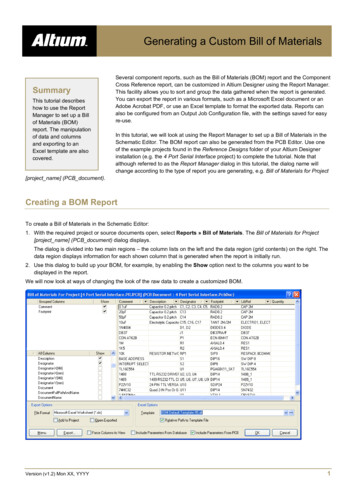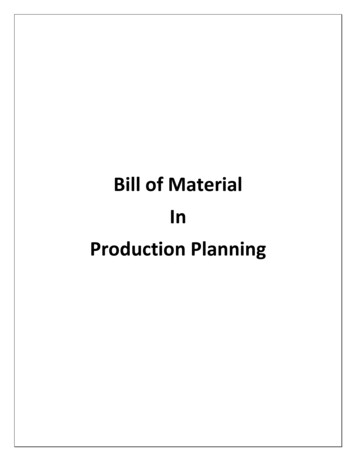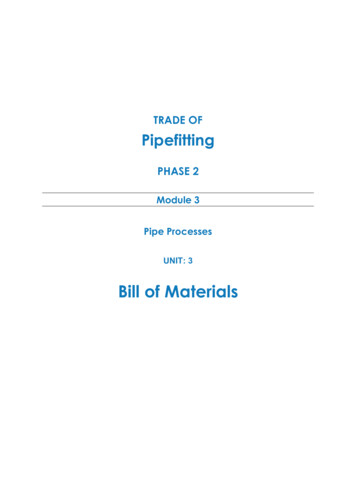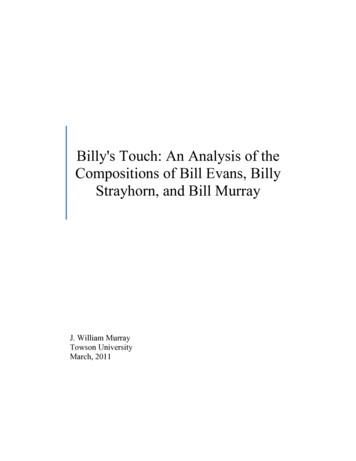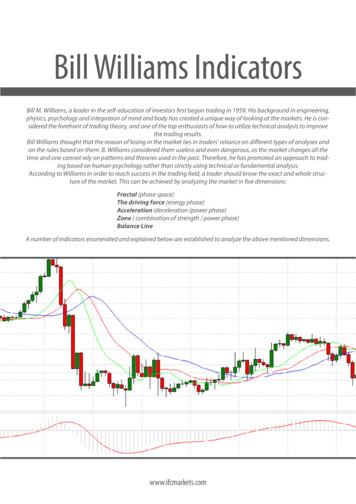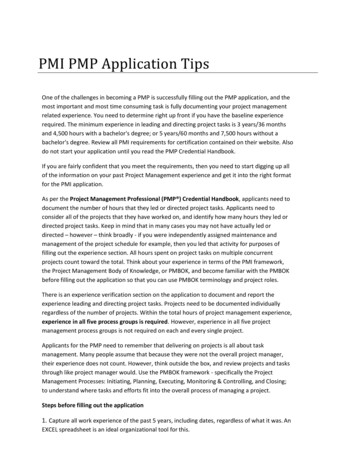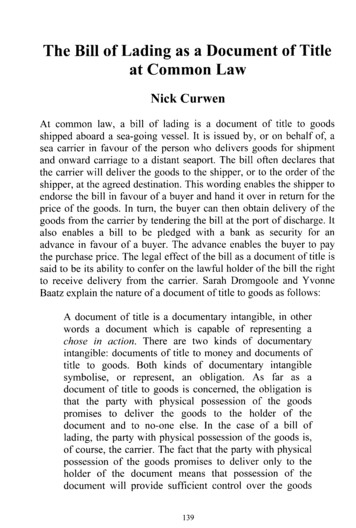
Transcription
The Bill of Lading as a Document of Titleat Common LawNick CurwenAt common law, a bill of lading is a document of title to goodsshipped aboard a sea-going vessel. It is issued by, or on behalf of, asea carrier in favour of the person who delivers goods for shipmentand onward carriage to a distant seaport. The bill often declares thatthe carrier will deliver the goods to the shipper, or to the order of theshipper, at the agreed destination. This wording enables the shipper toendorse the bill in favour of a buyer and hand it over in return for theprice of the goods. In turn, the buyer can then obtain delivery of thegoods from the carrier by tendering the bill at the port of discharge. Italso enables a bill to be pledged with a bank as security for anadvance in favour of a buyer. The advance enables the buyer to paythe purchase price. The legal effect of the bill as a document of title issaid to be its ability to confer on the lawful holder of the bill the rightto receive delivery from the carrier. Sarah Dromgoole and YvonneBaatz explain the nature of a document of title to goods as follows:A document of title is a documentary intangible, in otherwords a document which is capable of representing achose in action. There are two kinds of documentaryintangible: documents of title to money and documents oftitle to goods. Both kinds of documentary intangiblesymbolise, or represent, an obligation. As far as adocument of title to goods is concerned, the obligation isthat the party with physical possession of the goodspromises to deliver the goods to the holder of thedocument and to no-one else. In the case of a bill oflading, the party with physical possession of the goods is,of course, the carrier. The fact that the party with physicalpossession of the goods promises to deliver only to theholder of the document means that possession of thedocument will provide sufficient control over the goods139
THE BILL OF LADINGthat the holder will obtain constructive possession of thegoods . Transfer of the document will therefore giveconstructive delivery of the goods. Because the holder ofthe document has constructive possession of the goods,should the party in physical possession of the goods breakits obligation embodied in the document of title anddeliver to someone other than the holder of the document,the latter will be able to sue the obligor in the tort ofconversion for misdelivery. 1This passage has been chosen because it explains a document of titlein greater detail than is normally the case. Usually all that is said byway of explanation is that in its character as a document of title togoods, a bill of lading embodies constructive or symbolic possessionof the goods and that a transfer of the bill also transfers the possessionlocked up within it. It will be argued here that the explanation byDromgoole and Baatz of the legal character of a bill of lading as adocument of title is flawed and that a bill of lading neither representsa chose in action nor does it necessarily entitle its lawful holder to suethe carrier in conversion.A) A Short History of the Bill of Lading as a Document of TitleThe legal nature of a bill of lading as a document of title at commonlaw begins with Lickbarrow v Mason. 2 In that case, the special verdictof the jury found that, by the custom of merchants, the transfer of abill of lading transferred the property in the goods. When the case firstcame before the courts in King's Bench, Buller J. had said: 'no specialaction on the bill of lading has ever been brought; for if the bill oflading transfers the property, an action of trover against the captainfor non-delivery, or against any other person who seizes the goods, isnd1 N. Palmer and E. McKendrick (eds), Interests in GOOd5, 2edn (LLP: London, 1998), ch22, 'The Bill of Lading as a Document of Title', p 549, (footnotes from the original text areomitted).2(1794) 5 TR 683.140
THE BILL OF LADINGthe proper form of action.,3 Therefore, the reason why a lawful holderof a bill of lading could sue in conversion (trover being the old namefor the action) was that it embodied property in the goods.The subsequent history of the bi II oflading as a document of title hasseen the courts replacing ownership with possession as the interestembodied in the document. 4 In Barber v Meyerstein,5 the House ofLords explained a bill of lading as representing the goods and being asymbol of possession. Sanders v Maclean followed this,6 whereBowen LJ said:A cargo at sea while in the hands of the carrier isnecessarily incapable of physical delivery. During thisperiod of transit and voyage, the bill of lading by the lawmerchant is universally recognised as its symbol, and theendorsement and delivery of the bill of lading operates as asymbolical delivery of the cargo . It is a key which in thehands of a rightful owner is intended to unlock the door ofthe warehouse, floating or fixed, in which the goods maychance to be.?The final stage of this volte:face came with Sewell v Burdick,8 whereLord Bramwell, in the House of Lords, pointed out that ownership orthe general property in the goods was transferred according to theparties' intention and that intention was to be found in the contract forthe sale of the goods. It may be that the parties intended that a transferof the bill of lading should also transfer the property in the goods to3(1787) 2 TR 63, p75.For a comprehensive review of this process see Michael D. Boals, The Bill ofLading (LL?:London, 1997), ch 7.45(1870) LR 4 HL 317.(, (1883) II QBD 327.7Ibid, p341.8(1884) 10 App Cas 74.141
THE BILL OF LADINGthe buyer but that was a matter to be determined by the sale contract.Property in the goods was not inherently bound up in the bill. Theeffect of this development was to detach ownership from the bill oflading, leaving the bill as the embodiment of symbolic or constructivepossession. An unfortunate consequence of this transition is that itdestroys Buller J's explanation for the potency of a bill of lading. 9 Ifproperty is no longer necessarily embodied in a bill of lading, then itwould seem that its holder cannot be guaranteed an action inconversion against the carrier. To understand the reason for thispessimism we need to consider the nature of constructive possessionand the ability to sue in conversion.B) The Bill of Lading as the Embodiment of ConstructivePossessionMost judges and most commentators have used the terms'constructive possession' and 'symbolic possession' as if they meantthe same thing. The modem preference seems to favour constructivepossession so that is the term that will be used here.When a shipper delivers goods into the custody of a sea carrier, it isregarded as creating a bailment at will. lO In bailments at will thebailee holds the goods to the order of the bailor and must return themon demand provided all outstanding charges have been paid. Thisright to control the bailee has been the justification for regarding thebailor as having constructive possession. But this puts the matter thewrong way round because it bases constructive possession on a rightrather than a fact. Just because the bailor has the right to control thebailee does not mean that the bailee will comply.The idea of possession has at its core the notion of control or powerover goods. If we look at a bailment at will, then clearly the baileeexercises immediate physical control over the goods and therefore issaid to have possession. This is a matter of fact that can be observed;9See the passage referred to in fn 3 above.10 See Scothorn v South Staffordshire Railway (1853) 8 Ex 341; and Transcontainer ExpressLtd. v Custodian Security Ltd. [1988] 1 Lloyd's Rep 128.142
THE BILL OF LADINGthere is no need for recourse to legal rules to detennine whether anyparticular person has immediate physical control over goods. 11 But thebailee at will does not control the goods on their own account; theycontrol the goods on behalf of the bailor. So long as the bailee at willholds the goods on behalf of the bailor, then the latter has constructivepossession. Although the bailor has the legal right to insist that thebailee holds the goods to the order of the bailor, the latter'sconstructive possession is not simply a matter of legal right. It is thecontinued consent of the bailee to hold the goods on behalf of thebailor that supports the latter's constructive possession, and thebailee's consent is a matter of fact. As soon as the bailee refuses todeliver up the goods on demand because, for instance, the baileeasserts a lien over the goods, then the bailor's constructive possessionvanishes. It is, therefore, a precarious fonn of possession that dependsfor its continuance not upon any right of the bailor to exercise controlbut upon the intent of the person with immediate custody. The baileealways has it within their power to reject the bailor's control.The bailor at will's constructive possession has been held sufficient tosue strangers in trespass and conversion. 12 That is because, as againststrangers, possession is evidence of title, but the bailee is no stranger.At common law, a bailee cannot deny their bailor's title, but that titlepre-dates any delivery and is based upon the bailor's presumptiveownership rather than their constructive possession. The bailor's rightto delivery of the goods derives from other sources, which are: (I) thebailor's right to possession as presumptive owner, (2) the contract ofcarriage and (3) the bailment. The common view that constructivepossession represents a right to possession would, therefore, seem tobe wrong and Buller J was right when he said that 'no special actionon the bill of lading has ever been brought.' 13See P J Fitzgerald (ed), Salmond on Jurisprudence, 12 th edn (London, Sweet and Maxwell,1966), pp 266-267.II12 For trespass see Lotan v Cross (18 I0) 2 Camp 464 and for conversion see Nicolls vBastard (1835) 2 C M & R 659.13See the passage referred to in fn 3 above.143
THE BILL OF LADINGC) A Critique of Constructive Possession as an Entitlement1. Possession as Exclusive ControlAt its most basic, possession is not a right but simply a state of affairs;it describes not a legal relationship but a physical relationshipbetween a person and an object, based upon physical control. Thissimple notion of possession is responsible for the idea that possessionis exclusive and cannot be shared. It is aptly expressed by the Romanjurist, Paul, who said: 'The same possession cannot be in two personsany more than you can be considered to stand in the place in which Iam standing, or to sit in the place in which I am sitting.' 14 Theadvantage of this limited notion of possession is that it enables a strictdistinction to be maintained between possession and ownership.Possession is a fact whereas ownership is an entitlement. Facts aredetermined by observation whereas entitlements are determined byreference to legal rules. Whilst the common law pays lip service to thedistinction between possession and ownership, in practice thedistinction is often blurred by a far from clear conception ofpossession, which is permitted to trespass on the preserve ofownership.The notion of possession has been constricted and expanded by thecommon law to suit pragmatic requirements. If a remedy wasappropriate but the facts did not quite fit the legal action, then thefacts were adjusted to fit the action. Thus, an employee, havingcustody of their employer's goods, is not regarded as havingpossession because, as against strangers, the appropriate claimant isthe employer and not the employee. Others, who have no immediatephysical control, are regarded as in possession because they seem tobe the most appropriate claimants. In some cases, where a person doesnot have factual possession but clearly has the right to immediatepossession, they are regarded as having sufficient possession to sue intrespass. 15 To accommodate this flexibility, the common law adopted14Diges/41.2.3.5.15 They include: (I) a trustee where the goods are held by a beneficiary, (2) an executor oradministrator before grant of probate or letters of administration where they do not actually144
THE BILL OF LADINGa distinction between factual possession and legal possession.1 6 Thefirst involves physical control or what is called custody or detention.The second involves a legal relation between the person and theobject sufficiently close for us to regard the person as possessing theobject. This includes those with a legal right to immediate possessionand they are listed in footnote 15 above. However, the fourthexample, a bailor at will, is not like the others because it is the onlyexample where another person holds the goods on behalf of theconstructive possessor. Beneficiaries cannot be regarded as holdingthe goods on behalf of the trustee; they hold the goods for their ownbenefit. In the other two cases, no one else is in factual possession ofthe goods. There is, therefore, much greater force behind the assertionthat in the case of a bailment at will the bailor's constructivepossession is based upon a fact rather than a right.The doctrine of exclusive possession undoubtedly creates a problemfor the bailor at will. If the bailee has possession then the bailor mustbe out of possession. The common law overcame this difficulty byascribing to the bailor at will constructive possession and permittingthis to be used as the basis for suing in both trespass and conversion.If we are to pay more than lip service to the notion that possession isexclusive, then it would seem that we must either regard the bailorand bailee as sharing possession or as having different types ofposseSSIOn.The theory that the bailee at will is in possession of the goods that areshared with the bailor was advanced by Mellish LJ in Ancona vRogers 17 and by Lord Porter USA v Do(fus and the Bank ofEngland. 18possess the deceased's goods, (3) the owner of a franchise (for example, to take wrecks ortreasure trove) before th
At common law, a bill of lading is a document of title to goods shipped aboard a sea-goingvessel. It is issued by, or on behalf of, a sea carrier in favour ofthe person who delivers goods for shipment and onward carriage to a distant seaport. The bill often declares that the carrier will deliver the goods to the shipper, or to the order ofthe shipper, at the agreed destination. This wording .


